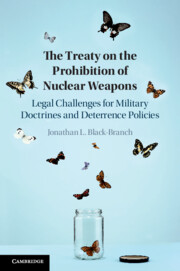 The Treaty on the Prohibition of Nuclear Weapons
The Treaty on the Prohibition of Nuclear Weapons Book contents
- The Treaty on the Prohibition of Nuclear Weapons
- Reviews
- The Treaty on the Prohibition of Nuclear Weapons
- Copyright page
- Contents
- Foreword
- Preface
- Acknowledgments
- Abbreviations
- 1 Changing the Status Quo in Nuclear Arms Control Law: The Treaty on the Prohibition of Nuclear Weapons 2017
- 2 Adopting the Treaty on the Prohibition of Nuclear Weapons 2017: A New Dawn, a New Deal, a New Direction in Nuclear Disarmament Law?
- 3 Humanitarian Nuclear Disarmament: Challenging the Status Quo through New Approaches to Legal Process, Purpose and Provisions
- 4 Legal Congruence with Existing Treaty Obligations: Toward Complementary or Competing Interests?
- 5 Customary International Law, Opinio Juris and State Practice Regarding the Treaty on the Prohibition of Nuclear Weapons 2017: Toward Universality?
- 6 Treaty Safeguards, Verification and Implementation: A Simple-Ban Approach and a Need for Oversight
- 7 Nuclear Deterrence Policies and the Prohibition Treaty: Disarmament Considerations
- 8 Nuclear Defense Doctrines: Disarmament and Emerging Humanitarian Concerns
- 9 Competition, Fragmentation and Polarization: A Bifurcated International Legal Infrastructure Regarding the Nuclear Architecture and Regulation?
- 10 Stigmatization-Action and Changing Global Perceptions to Delegitimize and Eliminate Nuclear Weapons
- 11 Toward Neo-Universalism: Toward a New Reality in International Law?
- 12 Obligations Erga Omnes: The Missing Link for Nuclear Nonproliferation and Disarmament Compliance
- 13 The Treaty on the Prohibition of Nuclear Weapons within the Nuclear Nonproliferation and Security Architecture in International Law: From Grand Bargain to Grand Challenges with the Right to Nuclear Peace and Freedom from Nuclear Fear: Summaries and Conclusions
- Index
12 - Obligations Erga Omnes: The Missing Link for Nuclear Nonproliferation and Disarmament Compliance
Published online by Cambridge University Press: 17 April 2021
- The Treaty on the Prohibition of Nuclear Weapons
- Reviews
- The Treaty on the Prohibition of Nuclear Weapons
- Copyright page
- Contents
- Foreword
- Preface
- Acknowledgments
- Abbreviations
- 1 Changing the Status Quo in Nuclear Arms Control Law: The Treaty on the Prohibition of Nuclear Weapons 2017
- 2 Adopting the Treaty on the Prohibition of Nuclear Weapons 2017: A New Dawn, a New Deal, a New Direction in Nuclear Disarmament Law?
- 3 Humanitarian Nuclear Disarmament: Challenging the Status Quo through New Approaches to Legal Process, Purpose and Provisions
- 4 Legal Congruence with Existing Treaty Obligations: Toward Complementary or Competing Interests?
- 5 Customary International Law, Opinio Juris and State Practice Regarding the Treaty on the Prohibition of Nuclear Weapons 2017: Toward Universality?
- 6 Treaty Safeguards, Verification and Implementation: A Simple-Ban Approach and a Need for Oversight
- 7 Nuclear Deterrence Policies and the Prohibition Treaty: Disarmament Considerations
- 8 Nuclear Defense Doctrines: Disarmament and Emerging Humanitarian Concerns
- 9 Competition, Fragmentation and Polarization: A Bifurcated International Legal Infrastructure Regarding the Nuclear Architecture and Regulation?
- 10 Stigmatization-Action and Changing Global Perceptions to Delegitimize and Eliminate Nuclear Weapons
- 11 Toward Neo-Universalism: Toward a New Reality in International Law?
- 12 Obligations Erga Omnes: The Missing Link for Nuclear Nonproliferation and Disarmament Compliance
- 13 The Treaty on the Prohibition of Nuclear Weapons within the Nuclear Nonproliferation and Security Architecture in International Law: From Grand Bargain to Grand Challenges with the Right to Nuclear Peace and Freedom from Nuclear Fear: Summaries and Conclusions
- Index
Summary
One of the fundamental problems with the TPNW is that the five officially recognized nuclear-weapons states – Russia, the United States, China, France and the United Kingdom, collectively the NWS – and four other states who possess nuclear weapons – India, Pakistan, Israel and North Korea – have boycotted the Treaty negotiations and refused to sign or ratify it. Despite moves toward neo-universalism, this leaves an important gap in the TPNW legal framework, because it does not directly bind the NWS and it seems unlikely that these NWS will join the Treaty or be bound under opinio juris. One way to remedy this problem and fill the legal gap is to appeal to an existing set of legal obligations found in international jurisprudence to which NWS are already bound. Specifically, the International Court of Justice (ICJ) has highlighted that states owe obligations erga omnes – toward all – that derive from other international laws, legal principles and conventions.
Keywords
- Type
- Chapter
- Information
- The Treaty on the Prohibition of Nuclear WeaponsLegal Challenges for Military Doctrines and Deterrence Policies, pp. 340 - 376Publisher: Cambridge University PressPrint publication year: 2021
